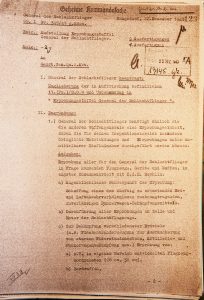The creation of Test Unit 26 – Erprobungskommando 26 – was long overdue when it was established in December 1943. It was created as the direct result of the severe pressure the Wehrmacht was under on the Eastern Front because of massive Russian tank formations. Tasked with the “… testing of all relevant aircraft types, equipment and weapons for the General der Schlachtflieger, in close cooperation with K.d.E. Rechlin [the main Luftwaffe test centre, located north of Berlin]” its immediate assignment was to create airborne weapons for fighting armoured vehicles. Test centre Rechlin had previously been involved in the testing of the Henschel Hs 129 anti-tank aircraft, as well as air-to-ground attack methods, so there were experienced personnel ready to take up the task.
For the actual testing of aircraft and weaponry, the 11. Staffel (Pz.) of Schlachtgeschwader 9 was renamed Erprobungskommando 26. This unit had previously been fighting Russian armour during the autumn of 1943 on the central and southern sectors of the Eastern Front, mostly in the area between Kiev and Kirovograd. 11.(Pz)/SG 9 transferred to Udetfeld near Gleiwitz (south-western Poland) in late December and was placed under the command of the General der Schlachtflieger, who was also responsible for supplying airmen. Supply of aircraft and equipment was to be provided by Genst.Gen.Qu.6.Abt (the Luftwaffe Generalquartiermeister 6. Abteilung), which was the organization responsible for handling all equipment and personnel in the Luftwaffe, as well as registering its losses (more about Genst.Gen.Qu.6.Abt here: link)
The commander of Erprobungskommando 26 was Major Eggers. He had the overall responsibility of running the research unit, and controlled personnel and technical matters. Herbert Eggers was born on 23 August 1913, and served as a fighter pilot during the Battle of Britain. He later moved on to an anti-tank unit, leading 13.(Pz.)/JG 51.
EKdo 26 was based at Udetfeld from establishment until January 1945, and was disbanded at Greifswald, northern Germany, in April 1945. Its authorised strength was eighteen aircraft, and it usually reported four Ju 87s, four Fw 190s, four Hs 129s, and four nocturnal ground-attack aircraft in its inventory, as well as two liaison aircraft.
As 1944 progressed, the testing of anti-tank rockets on Focke-Wulf 190s became a major task, and late in that year the unit had a constantly changing personnel roster, with numerous men from frontline units coming and going, receiving training on Panzerschreck-equipped Fw 190s.
One of the men joining EKdo 26 at Udetfeld in October 1944 was Leutnant Werner Zirus, a highly experienced Schlachtflieger. He undertook his first Fw 190 Erprobung flight with EKdo 26 on 4 October, and then three the next day. Simultaneously joining the unit was a man whose name was noted by a civilian attached to the unit as “Lt. Dommatzki”. This was actually Leutnant Otto Dommeratzky, a Ritterkreuz winner. Soon after completing his time at EKdo 26, Dommeratzky was on his way back to his operational unit when he was killed by American fighter aircraft during a ferry flight 130 kilometres south-west of Udetfeld.
Ritterkreuz winner and Stuka veteran Oberleutnant Erhard Jähnert of III./SG 3 was another prominent pilot who learnt how to use anti-tank rockets with EKdo 26 at Udetfeld. He arrived there on 31 October, and noted in his memoirs: “On 31 October 1944 I was in the machine, the Focke-Wulf 190, in order to make myself familiar with the equipment to fire the Panzerfaust from the air”. 1 November saw theoretical training, and the next day Jähnert undertook six practise flights in an Fw 190 F-8. He then left Udetfeld behind to rejoin his operational unit.
Although only a small outfit, Herbert Egger’s EKdo 26 was responsible for some important developments in German anti-tank warfare, and the anti-tank rocket-equipped Fw 190s were particularly important in the closing stages of the war.

Fw 190 F-8 equipped with Panzerschreck. The four launch mechanisms were mounted on the standard wing bomb racks and housed three rockets each, so a total of twelve rockets could be carried.





